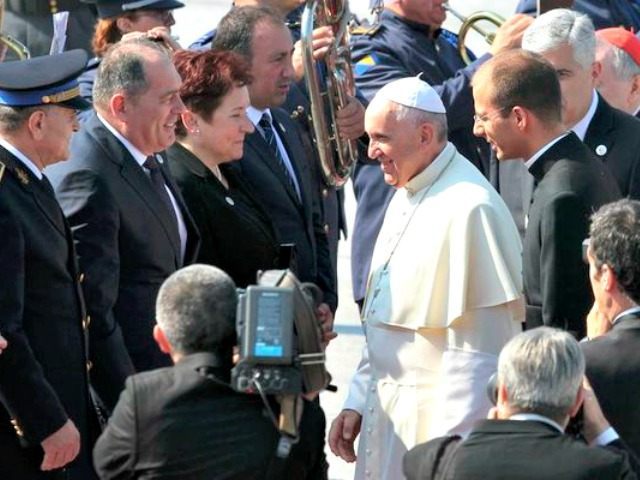In his one-day visit to Bosnia and Herzegovina Saturday, Pope Francis held up Sarajevo as an example for the whole world of peaceful coexistence among Jews, Christians, and Moslems, who for centuries maintained their distinct cultures and beliefs yet lived together in harmony.
In his meeting with authorities and the diplomatic corps at the Presidential Palace, the Pope spoke of the city’s remarkable recovery after having “suffered so much in the bloody conflicts of the past century,” so that it has once again “become a place of dialogue and peaceful coexistence.”
“Bosnia and Herzegovina,” he said, “has advanced from a culture of conflict and war to a culture of encounter.”
Francis said that the very layout of Sarajevo with synagogues, churches, and mosques in close proximity to each other “reveals visible and substantial characteristics of these different communities,” so much so that “Sarajevo has been called ‘The Jerusalem of Europe.’”
Sarajevo is renowned for its cultural and religious diversity. In fact, until late in the 20th century, it was “the only major European city to have a mosque, Catholic church, Orthodox church, and synagogue within the same neighborhood.”
Francis said that the city “represents a crossroads of cultures, nations and religions,” a situation that has required great flexibility, generosity, and respect.
For centuries, he said, communities were present in Sarajevo who professed different religions, “without these differences having impeded for any length of time the establishment of mutually fraternal and cordial relationships.”
What is needed for such harmony to endure, Francis said, is the ability “to discover the gifts of each person, to promote that which unites us, and to regard our differences as an opportunity to grow in mutual respect.”
This is essential, Francis said, not only for the future of the Balkans, but as an example for the whole world that such coexistence is possible.
He said that peace and harmony among Croats, Serbs, and Bosnians, as well as the cordial relations among Muslims, Jews, and Christians, “take on an importance that goes beyond its boundaries.”
These initiatives, the Pope said, “offer a witness to the entire world that such cooperation among varying ethnic groups and religions in view of the common good is possible; that a plurality of cultures and traditions can coexist and give rise to original and effective solutions to problems; that even the deepest wounds can be healed by purifying memories and firmly anchoring hopes in the future.”
Francis said that he had witnessed this himself on arriving at the airport Saturday morning, where he was greeted by Muslims, Orthodox Jews, Catholics, and members of other religions “together and joyful!”
“This is a sign of hope!” he said.
The Pope contrasted this example of peaceful coexistence with other situations in the world, with obvious reference to the Islamic State and other Jihadist groups.
“In order to successfully oppose the barbarity of those who would make of every difference the occasion and pretext for further unspeakable violence,” he said, “we need to recognize the fundamental values of human communities, values in the name of which we can and must cooperate, build and dialogue, pardon and grow.”
This is the way that different voices will “unite in creating a melody of sublime nobility and beauty, instead of the fanatical cries of hatred,” he said.
Francis also took advantage of the occasion to once again push the right to religious freedom, insisting that for social harmony to come about “It is vital that all citizens be equal both before the law and its implementation, whatever their ethnic, religious or geographical affiliation.”
Enjoying the same rights, he said, “they will be able to make their specific contribution to the common good.”
Francis ended his address expressing the hope that “leaving behind completely the dark clouds of storms gone by,” Bosnia and Herzegovina may continue along the journey embarked upon, “so that after the winter chill, springtime may come to blossom.”
Follow Thomas D. Williams on Twitter @tdwilliamsrome

COMMENTS
Please let us know if you're having issues with commenting.